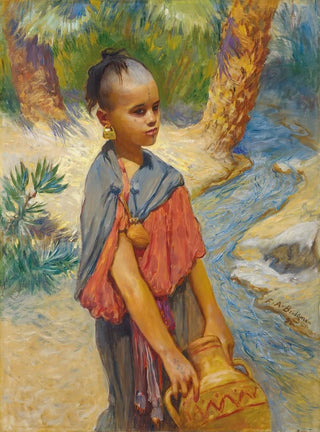Art print | A Young Girl by the Riverbank - Frederick Arthur Bridgman Source: Reproduction | Une jeune fille au bord d'une rivière - Frederick Arthur Bridgman


View from behind

Frame (optional)
In the world of art, some works manage to capture the very essence of beauty and serenity. "A Young Girl by the Riverbank" by Frederick Arthur Bridgman is a perfect example. This canvas, imbued with poetry, transports us to a world where nature and humanity meet harmoniously. The scene depicts a young woman, delicately seated by the riverbank, lost in her thoughts, while the shimmering water reflects the daylight. The painting evokes an atmosphere of tranquility and contemplation, inviting the viewer to immerse themselves in this suspended moment in time.
Style and uniqueness of the work
Bridgman's work stands out for its unique style, blending realism and impressionism. The meticulous details of the young girl, from her light dress to the reflections in the water, demonstrate remarkable technical mastery. The colors, both vivid and soft, create a striking contrast that draws the eye and captivates the imagination. Light plays a crucial role in this composition, bathing the scene in a soothing warmth. Every brushstroke seems alive, as if the gentle breeze and the murmur of the water accompany the viewer on this visual journey. Bridgman succeeds in establishing a dialogue between the human figure and the surrounding nature, thus revealing the intrinsic beauty of each element.
The artist and his influence
Frederick Arthur Bridgman, an American painter of the 19th century, established himself as an emblematic figure of his time. Influenced by his travels in Europe, notably in France and Egypt, he developed a style that combines Eastern and Western influences. Bridgman was able to capture the spirit of his era, exploring themes such as nature, women, and exoticism. His ability to translate deep emotions through his works has inspired many contemporary and later artists. By incorporating elements of his own cultural experience, he enriched the artistic landscape of his time, leaving a lasting imprint on art history. His work continues to be celebrated for its timeless beauty and his commitment to representing life in all its facets.

Matte finish

View from behind

Frame (optional)
In the world of art, some works manage to capture the very essence of beauty and serenity. "A Young Girl by the Riverbank" by Frederick Arthur Bridgman is a perfect example. This canvas, imbued with poetry, transports us to a world where nature and humanity meet harmoniously. The scene depicts a young woman, delicately seated by the riverbank, lost in her thoughts, while the shimmering water reflects the daylight. The painting evokes an atmosphere of tranquility and contemplation, inviting the viewer to immerse themselves in this suspended moment in time.
Style and uniqueness of the work
Bridgman's work stands out for its unique style, blending realism and impressionism. The meticulous details of the young girl, from her light dress to the reflections in the water, demonstrate remarkable technical mastery. The colors, both vivid and soft, create a striking contrast that draws the eye and captivates the imagination. Light plays a crucial role in this composition, bathing the scene in a soothing warmth. Every brushstroke seems alive, as if the gentle breeze and the murmur of the water accompany the viewer on this visual journey. Bridgman succeeds in establishing a dialogue between the human figure and the surrounding nature, thus revealing the intrinsic beauty of each element.
The artist and his influence
Frederick Arthur Bridgman, an American painter of the 19th century, established himself as an emblematic figure of his time. Influenced by his travels in Europe, notably in France and Egypt, he developed a style that combines Eastern and Western influences. Bridgman was able to capture the spirit of his era, exploring themes such as nature, women, and exoticism. His ability to translate deep emotions through his works has inspired many contemporary and later artists. By incorporating elements of his own cultural experience, he enriched the artistic landscape of his time, leaving a lasting imprint on art history. His work continues to be celebrated for its timeless beauty and his commitment to representing life in all its facets.






